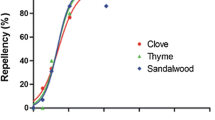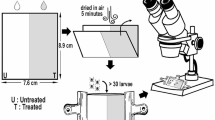Abstract
Lone star ticks are aggressive ectoparasites of domestic and wild animals, as well as humans. These ticks can transmit many pathogens that cause disease including Erhlichia and tularemia. Common compounds used for personal protection and area sprays are N-diethyl-3-methyl benzamide (DEET) and permethrin, but public concern over personal and environmental safety require the development of new, safer products. In the current study, four commercially available products (Wondercide, Essentria IC3, Vet’s Best, and Mosquito Barrier) were tested for both repellent and toxic effects against lone star tick nymphs and adults. Overall, all four products were more effective against nymphs than against adults. Wondercide and Essentria IC3 were as toxic to nymphs as permethrin at concentrations of 3.13% and higher, and as repellent as DEET at all concentrations. Nymphs were also repelled by Mosquito Barrier and Vet’s Best, but these products had about half or less of the repellent effects of Wondercide and Essentria IC3 at most of the concentrations. Adult ticks were repelled similarly by all products at all tested concentrations, but at lower levels than nymphs. Toxicity of the four tested products on adults was similar at concentrations of 12.5% and below, less than half of what was observed with permethrin with declining effectiveness as concentrations decreased. Overall, these four products may offer a natural way to repel lone star ticks, but further field testing is needed to determine rates of application and residual activity.


Similar content being viewed by others
References
Barrett AW, Noden BH, Gruntmeir JM, Holland T, Mitcham JR, Martin JE, Johnson EM, Little SE (2015) County scale distribution of Amblyomma americanum (Ixodida: Ixodidae) in Oklahoma: addressing local deficits in tick maps based on passive reporting. J Med Entomol 52:269–273
Bharadwaj A, Hayes LE, Stafford KCIII (2015) Effectiveness of garlic for the control of Ixodes scapularis (Acari: Ixodidae) on residential properties in western Connecticut. J Med Entomol 52:722–725
Bissinger BW, Roe RM (2010) Tick repellents: past, present, and future. Pestic Biochem Physiol 96:63–79
Bissinger BW, Zhu J, Apperson CS, Sonenshine DE, Watson DW, Roe RM (2009) Comparative efficacy of BioUD to other commercially available arthropod repellents against the ticks Ablyomma americanum and Dermacentor variabilis on cotton cloth. Am J Trop Med Hyg 81:685–690
Bissinger BW, Schmidt JP, Owens JJ, Mitchell SM, Kennedy MK (2014) Activity of the plant-based repellent, TT-4302 against the ticks Amblyomma americanum, Dermacentor variabilis, Ixodes scapularis and Rhipicephalus sanguineus (Acari: Ixodidae). Exp Appl Acarol 62:105–113
Carroll JF, Cantrell CL, Klun JA, Kramer M (2007) Repellency of two terpenoid compounds isolated from Callicarpa americana (Lamiaceae) against Ixodes scapularis and Amblyomma americanum ticks. Exp Appl Acarol 41:215–224
Carvalho-Filho JLS, Blank AF, Alves PB, Ehlert PAD, Melo AS, Cavalcanti SCH, Arrigoni-Blank MF, Silva-Mann R (2006) Influence of the harvesting time, temperature and drying period on basil (Ocimum basilicum L.) essential oil. Rev Bras Farmacogn 16:24–30
Childs J, Paddock C (2003) The ascendancy of Amblyomma americanum as a vector of pathogens affecting humans in the United States. Annu Rev Entomol 8:307–337
Dolan MC, Jordan RA, Schulze TL, Schulze CJ, Manning MC, Ruffolo D, Schmidt JP, Piesman J, Karchesy JJ (2009) Ability of two natural products, nootkatone and carvacrol, to suppress Ixodes scapularis and Amblyomma americanum (Acari: Ixodidae) in a Lyme disease endemic area of New Jersey. Econ Entomol 102:2316–2324
Elias SP, Lubelczyk CB, Rand PW, Staples JK, St Amand TW, Stubbs CS, Lacombe EH, Smith LB, Smith RP Jr (2013) Effect of a botanical acaricide on Ixodes scapularis (Acari: Ixodidae) and non-target arthropods. J Med Entomol 50:126–136
Garboui SS, Jaenson TG, Borg-Karlson AK, Pålsson K (2007) Repellency of methyl jasmonate to Ixodes ricinus nymphs (Acari: Ixodidae). Exp Appl Acarol 42:209–215
Ginsberg HS, Stafford KC (2005) Management of ticks and tick-borne diseases. In: Goodman JL, Dennis DT, Sonenshine DE (eds) Tickborne diseases of humans. ASM Press, Herndon, pp 65–86
Ginsberg HS, Ewing CP, O’Connell AF, Bosler EM, Daley JG, Sayre MW (1991) Increased population densities of Amblyomma americanum (Acari, Ixodidae) on Long Island, New York. J Parasitol 77:493–495
Goddard J, Varela-Stokes AS (2009) Role of the lone star tick, Amblyomma americanum (L.), in human and animal diseases. Vet Parasitol 160:1–12
Jaenson TGT, Palsson K, Borg-Karlson AK (2005) Evaluation of extracts and oils of tick-repellent plants from Sweden. Med Vet Entomol 19:345–352
Jaenson TGT, Garboui S, Pålsson K (2006) Repellency of oils of lemon eucalyptus, geranium and lavender and the mosquito repellent MyggA Natural to Ixodes ricinus (Acari: Ixodidae) in the laboratory and field. J Med Entomol 43:731–736
Martinez-Velazquez M, Castillo-Herrera GA, Rosario-Cruz R, Flores-Fernandez JM, Lopez-Ramirez J, Hernandez-Gutierrez R, Lugo-Cervantes Edel C (2011) Acaricidal effect and chemical composition of essential oils extracted from Cuminum cyminum, Pimenta dioica and Ocimum basilicum against the cattle tick Rhipicephalus (Boophilus) microplus (Acari: Ixodidae). Parisitol Res 108:481–487
Means RG, White DJ (1997) New distribution records of Amblyomma americanum (L.) (Acari: Ixodidae) in New York State. J Vector Ecol 22:133–145
Mehlhorn H, Schmal G, Schmidt J (2005) Extract of the seeds of the plant Vitex agnus castus proven to be highly efficacious as a repellent against ticks, fleas, mosquitoes and biting flies. Parasitol Res 95:363–365
Meng H, Li AY, Costa LM Jr, Castro-Arellano I, Liu J (2016) Evaluation of DEET and eight essential oils for repellency against nymphs of the lone star tick, Amblyomma americanum (Acari: Ixodidae). Exp Appl Acarol 68:241–249
Mkolo NM, Sako KM, Olowoyo JO, Ndlovu S, Magano SR (2011) Variation in the repellency effects of the leaves of Mentha piperita against adults of Amblyomma hebraeum. African J Biotech 10:11426–11432
Muchjajib U, Muchjajib S (2010) Effect of picking time on essential oil yield of Ylang-Ylang (Cananga odorata). Acta Hortic 925:243–248
Panella NA, Karchesy J, Maupin GO, Malan JCS, Piesman J (1997) Susceptibility of immature Ixodes scapularis (Acari: Ixodidae) to plant-derived acaricides. J Med Entomol 34:340–345
Panella NA, Dolan MC, Karchesy JJ, Xiong Y, Peralta-Cruz J, Khasawneh M, Montenieri JA, Maupin GO (2005) Use of novel compounds for pest control: insecticidal and acaricidal activity of essential oil components from heartwood of Alaska yellow cedar. J Med Entomol 42:352–358
Piesman J, Eisen L (2008) Prevention of tick-borne diseases. Annu Rev Entomol 53:1–21
Rand PW, Lacombe EH, Elias SP, Lubelczyk CB, St. Amand T, Smith RP Jr (2010) Trial of a minimal-risk botanical compound to control the vector tick of Lyme disease. J Med Entomol 47:695–698
Schulze TL, Jordan RA, Schulze CJ, Mixson T, Papero M (2005) Relative encounter frequencies and prevalence of selected Borrelia, Ehrlichia, and Anaplasma infections in Amblyomma americanum and Ixodes scapularis (Acari:Ixodidae) ticks from central New Jersey. J Med Entomol 42:450–456
Soleimani B, Khosh-Khui M, Ramezani S (2011) Planting date effects on growth, seed yield, essential oil content and chemical composition of Ajowan. J Appl Biol Sci 5:7–11
Springer YP, Eisen L, Beati L, James AM, Eisen RJ (2014) Spatial distribution of counties in the continental United States with records of occurrence of Amblyomma americanum (Ixodida: Ixodidae). J Med Entomol 51:342–351
Stafford KC III, Allan SA (2010) Field applications of entomopathogenic fungi Beauveria bassiana and Metarhizium anisopliae F52 (Hypocreales: Clavicipitaceae) for the control of Ixodes scapularis (Acari: Ixodidae). J Med Entomol 47:1107–1115
Stafford KC, Kitron U (2002) Environmental management for Lyme borreliosis control. In: Gray J (ed) Lyme borreliosis: biology and control. CABI Publishing, Oxon, pp 301–334
Stromdahl EY, Hickling GJ (2012) Beyond Lyme: aetiology of tick-borne human diseases with emphasis on the south-eastern United States. Zoonoses Pub Health 69:48
Stromdahl EY, Jiang J, Vince M, Richards AL (2011) Infrequency of Rickettsia rickettsii in Dermacentor variabilis removed from humans, with comments on the role of other human-biting ticks associated with spotted fever group Rickettsiae in the United States. Vector Borne Zoonotic Dis 11:969–977
Thorsell W, Mikiver A, Tunón H (2006) Repelling properties of some plant materials on the tick Ixodes ricinus L. Phytomedicine 13:132–134
Acknowledgements
The authors wish to thank Laura Beimfohr, Yasmine Hentati, Grace Hummell, and Patrick Roden-Reynolds for their help conducting the bioassays. We would also like to thank Bob Bennett for his time with administrative duties. This project was supported by funds from an ARS in-house Project (#8042-32000-008-00) - Prevention of Arthropod Bites.
Author information
Authors and Affiliations
Corresponding author
Additional information
This article reports the results of research only. Mention of a proprietary product does not constitute an endorsement or a recommendation by the USDA for its use. The USDA is an equal opportunity provider and employer.
Rights and permissions
About this article
Cite this article
Machtinger, E.T., Li, A.Y. Evaluation of four commercial natural products for repellency and toxicity against the lone star tick, Amblyomma americanum (Acari: Ixodidae). Exp Appl Acarol 73, 451–460 (2017). https://doi.org/10.1007/s10493-017-0185-z
Received:
Accepted:
Published:
Issue Date:
DOI: https://doi.org/10.1007/s10493-017-0185-z




